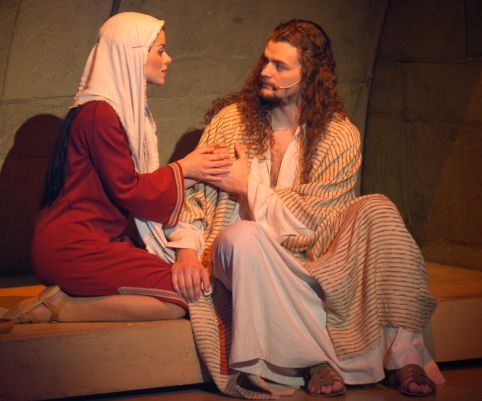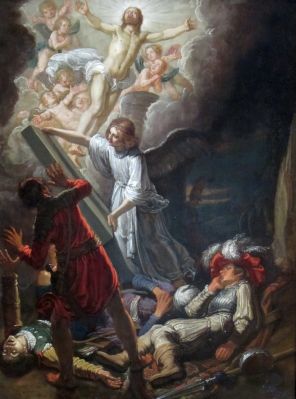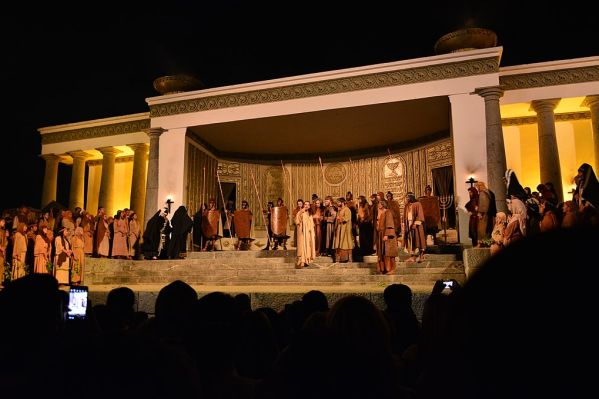Religious Theater – Concept, Relationships and Characteristics
Contents
What is Religious Theater?
The humanists who pursued a classical Greco-Latin ideal, went against the firmness with which the free experiences in the medieval theater had been constituted, therefore, they created the Religious theater that is located at the end of the XV century continuing until the middle of the XVI century. Likewise, the religious theater was the heir of the Middle Ages, linked to the liturgy, and it is with the liturgical drama as it was developed during the following two hundred years, the religious theater, from the biblical stories in which acted altar boys and young people of the choir.
At the beginning they wore the costumes of the celebration of the mass and the stage was the architectural forms of the church as a set, but later it was organized in a more formal way. Therefore, the stage was divided into two parts, the mansion and the stalls. Thus, the Mansion consisted of a small scenic structure, a small stage, a specific place, such as the city of Jerusalem or Heaven. While the Platea, was a neutral area in front of the mansion forming the actors’ space for the interpretation of the scene.
How did the Religious Theater develop?
The religious theater of the sixteenth century is not a homogeneous whole throughout the century, because, as far as it is reported had a division into two distinct stages, from the chronological point of view, at the time of Charles V and Philip II, that is, the first and second half of the century. Therefore, the freedom of ideas and openness that existed during the reign of the Emperor were replaced during the reign of his son by greater control and rigidity. A clear example of this can be seen in the publication in 1559 of the index of forbidden books by the Inquisitor General Fernando de Valdés, which included works that had previously been in free circulation in the first half of the 500s.
In this sense, of the Religious Theater of the XVI century, we only have a partial knowledge of what really existed, as affirmed by Pérez Priego in general reference to the Renaissance theater. So, of the religious theater, the information that there is, is in the body of the preserved works of the Spanish theater of the sixteenth century, by Miguel M. García-Bermejo Giner (1996). It is believed that it appeared between 1470 and 1587, with the development of an experimental theatrical practice that gave rise to the comedia nueva.
In the production and reception of this theater, there are differences between the first and second half of the century. While in the first half of the century religious theater was developed in a courtly environment and depended on the patronage of the nobles or the Church, in the second half, professional companies appeared and settled, the theater was freed from patronage and its servitudes, attending more to the satisfaction of a varied public. Therefore, authors such as Hermenegildo (1994), when structuring the theatrical conception in that century, do so from the concepts of captive audience and open audience.
When we speak of a captive audience, it is a select, closed audience that attends performances conditioned by its social insertion, including court, religious, university, collegiate and humanistic theater. In the second case, i.e., the open audience, we are dealing with an audience that is defined a priori by its unpredictable condition, including here the theater that responds to the principles of professionalism and the so-called theater of horror. That is to say, for this researcher, from the theory of reception, religious theater, in its different manifestations, would be found within the one destined to a captive audience.
However, the religious theater was also in the hands of professionals who represent hagiographic comedies in corrals before spectators who have to capture or who compete before the municipal councils to obtain the representations of the body, controlled even in its details by the capitulars to celebrate the Sacrament, in fight against heresy, to please and indoctrinate the public, as well as to satisfy the municipal pride, which leads to think if it is a religious theater directed to a captive audience in all the extension of the concept.
Therefore, for the author Hermenegildo, it is a closed public, to which the message arrives conditioned, with a predetermined purpose, a collective to which deviation and ideological divergence are not allowed. Therefore, moralization, catechesis, teaching become objectives that meet no deliberate resistance in this spectator.
With regard to the subject matter, religious theater, in the first half of the century is given towards the cultivation of religious dramas related to the liturgical cycles of Christmas and the Passion-Resurrection, of medieval heritage. Therefore, the plays are endowed with greater textual density with a didactic purpose full of profane elements with notes of comedy, both for the amusement of the spectators and to facilitate the didactic discourse.
What are the types of Religious Theater?
In the Christmas plays of this period, the traditional motifs of the announcement to the shepherds of the birth of Christ and the adoration of the newborn are renewed with the frequent introduction of allegorical or biblical themes and characters and a particular attention to the figure of Our Lady.
However, the great contribution of the religious theater of the sixteenth century, particularly in its second half, to the history of theater does not occur in the theater of liturgical cycles but in the celebration of the Eucharist during the feast of the corpus christi, with the configuration of a Spanish genre, the auto sacramental, which reached its fullness in the fifteenth century.
Therefore, the theatricality of this century is not limited to professional or semi-professional actors. There are also the occasional, amateur or amateur, belonging in scenic practices to the social framework in which they develop. Therefore, in court theatrical practice it is the authors of the plays themselves, the members of the nobility and their servants, who are in charge of the performances. Therefore, it could then be said that the types of religious theater staged were:
-The Religious Rite. A rite (from the Latin ritus) is a religious or ceremonial act invariably repeated in every cultural community. Rites are the celebrations of myths, therefore, they cannot be understood separately from them. They have a symbolic character, expression of the content of the myths. The celebration of the rites (ritual) can consist of feasts and ceremonies, of solemn character, according to guidelines established by the tradition or the religious authority or the corresponding organization.
The Trope. In medieval times, a musical form that prolonged and embellished the liturgy by adding text, music or both was called tropo. Often the music incorporated was ancient melismas of Greek or Roman origin. In Gregorian chant the trope consists of adding words to the melismas, which were used as a mnemonic device to facilitate memorization. Initially the text was inserted to explain the liturgy and later also for its embellishment.
The Catholic Church accepted to incorporate the trope into its liturgy as it embellished it without creating new elements. Over time, the new texts were incorporated into all elements of the Mass, although they are most frequent in the Introit and Kyrie, especially in the Alleluia which along with Benedicamus dominated as the most common examples of this musical form.
The Mystery. In the European theatrical context, it is the medieval religious drama that stages passages from the Holy Scriptures and, preferably, from the life, passion and death of Jesus Christ.
The Auto Sacramental. It is a piece of religious theater, a kind of liturgical drama, of allegorical structure, whose performance is given with a preferably Eucharistic theme, performed on the day of Corpus Christi, between the sixteenth and eighteenth centuries until the prohibition of the genre in 1765. A great scenographic apparatus was used and the representations included biblical episodes, mysteries of religion or conflicts of moral and theological character. Initially they were performed in the temples or porticos of churches. The oldest of the genre is the auto or the Representation of the Magi, from the year 1145.
The Procession. It is a religious parade organized by people who make a route, from one place to another, or departing from a place and returning to it. Processions exist in most of the major religions: Hinduism, Shintoism, Islam, Catholicism. In Christianity, processions are the most important part of external worship. Thus, the history of Christian processions, although in the early times of persecution were very strange, and only inside the places of worship, there is historical evidence of some processions in the Middle Ages.
The masquerade. It was a form of festive court entertainment that flourished in Europe between the sixteenth and early eighteenth centuries, although it had previously developed in Italy. The masquerade involved the use of music and dance, singing and acting, within an elaborate scenography, in which the architecture and costumes could be designed by a renowned architect, to represent a different allegory of patron worship.
Professional actors and musicians were hired for the spoken and sung aspects of the masquerade. Often, the non-speaking and non-singing masqueraders were courtiers.
The Troubadours. They were medieval musicians and poets, who composed their works and performed them, or had them interpreted by minstrels or minstrels, in the stately courts of certain places in Europe, especially in the south of France, between the 12th and 14th centuries. Troubadour poetry was composed mainly in Occitan.
The troubadours, characters mostly from the nobility, with their love songs above all, but also with their compositions of political propaganda, their debates and, in short, with their vision of the world, show the beginning of a cultural and political history that is not found in any other document of the time. Their literature, moreover, will be one of the basic sources of the poetry that will be cultivated in Western Europe for centuries.
The Minstrels. They were itinerant artists in Medieval Europe. In exchange for money or food, they offered their street spectacle in public squares, and sometimes they were hired to participate as attractions and entertainment in feasts and banquets. Scholars also point out the synonymy between minstrel and rogue and, in ancient times, with troubadour and poet.
To the most cultivated sector of minstrelsy we owe the preservation of a rich treasure, transmitted in the form of oral tradition, and which can range, in a very broad sense, from medieval epic poetry to pre-Renaissance court poetry.
Carnival. It is a celebration that takes place before the Christian Lent, (between February and March depending on the year), and that combines elements such as costumes, parades, and street parties. By extension, similar celebrations are called this way at any time of the year. In spite of the great differences that its celebration presents in the world, its common characteristic is that of being a period of permissiveness and lack of control.
Ethnologists find in carnival surviving elements of ancient festivals and cultures, such as the winter festival (Saturnalia), Greek and Roman Dionysian celebrations (Bacchanalia), pre-Hispanic Andean festivals and Afro-American cultures. Some authors consider that for the rural society, strongly structured by Christianity, the time of “carnestolendas” provided ritual masquerades of pagan roots and a time of permissiveness that opposed the repression of sexuality and the severe liturgical formality of Lent.
What is the legacy of the Religious Theater?
Although the term actor or representative has been used in the masculine gender, the presence of women on the stage in the Spain of that century should be emphasized, since the periods of prohibition of theatrical activity are very scarce and brief, if the repeated testimonies of many moralists are to be believed.
On the other hand, being a believer or not, declaring oneself agnostic, looking at religion with skepticism, the fact is that religious facts have been relevant and influential in the western world. Therefore, even in the XXI century, in the face of so many advances, the religious theme is widely recognized in societies, because it is related to many realities and disciplines.
Who are the main representatives of Religious Theater?
In the Christmas production of the first half of the century, the Portuguese Gil Vicente and the Extremaduran Diego Sánchez de Badajoz, wrote plays in the tradition of the shepherds’ theater, linked to the celebration of the birth of Christ as evidenced in the theater of Juan del Encina, Lucas Fernández, Bartolomé de Torres Naharro, Pero López Ranjel, Fernán López de Yanguas, Pedro Suárez de Robles and the same Gil Vicente and Diego Sánchez de Badajoz.
Lope de Rueda participated this time with two plays: Navalcarmelo, whose performance won him prizes in competition with four other authors of “carros”, and El hijo pródigo (The Prodigal Son). But his theatrical activity in Seville was not limited to the Corpus Christi performances, for in his will, he leaves a record of the performance of a farce for twelve days in a private house, that of the clergyman Juan de Figueroa, an active theater man in the middle years of the 16th century.
Thus, Lope de Rueda’s performances were paid for by the municipalities, the Church, the nobility (including royalty) and individuals of lower social standing, as Diago shows in his theatrical biography, making him, in his opinion, a significant example of the triple dependence between the Church, municipalities and nobility in the origins of professional theater.
The guild origin of the first professional actors is clearly shown in the performance of their respective professions that appears, for example, in documents consulted for the Corpus Christi in Seville during the second half of the 16th century, where the use of a specific denomination for the identification of these professionals, as the century progresses and this representative professionalism is consolidated, can also be seen from the same example.



